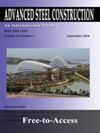风荷载作用下高层复合建筑钢支腿系统的最佳位置
IF 1.7
3区 工程技术
Q3 CONSTRUCTION & BUILDING TECHNOLOGY
引用次数: 8
摘要
复合建筑在风荷载下的响应显然变得越来越重要,因为建筑变得更高,更少的刚性和更轻的重量。当组合建筑的高度增加时,结构的刚度成为更重要的因素,通常采用带桁架和支腿系统来为结构提供足够的侧移刚度。迄今为止的研究工作大多局限于混凝土结构支腿体系的钢筋混凝土建筑,建筑平面布置简单,建筑高度单一,风向单一,支腿布置水平单一。在建筑平面布局、高度和支腿布置方式不同的情况下,组合建筑支腿水平在侧向风荷载作用下的有效位置研究工作还比较缺乏。本文的目的是通过对不同尺寸、形状和高度的组合建筑采用不同的单层和双层支腿布置,确定钢带和支腿系统的最佳位置。在这项研究中,对复合材料建筑原型进行了全面的有限元建模,三种不同的布局(矩形、八角形和L形)和三种不同的楼层(28层、42层和57层)。分析了钢带和支腿支撑不同组合形式下的动态旋风风荷载模型。结果表明,对于不同尺寸、形状和高度的组合建筑,单级钢带和双级钢带及支腿支撑在不同位置的作用是不同的。本文章由计算机程序翻译,如有差异,请以英文原文为准。
Optimum position of steel outrigger system for high rise composite buildings subjected to wind loads
The responses of composite buildings under wind loads clearly become more critical as the building becomes taller, less stiff and more lightweight. When the composite building increases in height, the stiffness of the structure becomes more important factor and introduction to belt truss and outrigger system is often used to provide sufficient lateral stiffness to the structure. Most of the research works to date is limited to reinforced concrete building with outrigger system of concrete structure, simple building plan layout, single height of a building, one direction wind and single level of outrigger arrangement. There is a scarcity in research works about the effective position of outrigger level on composite buildings under lateral wind loadings when the building plan layout, height and outrigger arrangement are varied. The aim of this paper is to determine the optimum location of steel belt and outrigger systems by using different arrangement of single and double level outrigger for different size, shape and height of composite building. In this study a comprehensive finite element modelling of composite building prototypes is carried out, with three different layouts (Rectangular, Octagonal and L shaped) and for three different storey (28, 42 and 57-storey). Models are analysed for dynamic cyclonic wind loads with various combination of steel belt and outrigger bracings. It is concluded that the effectiveness of the single and double level steel belt and outrigger bracing are varied based on their positions for different size, shape and height of composite building.
求助全文
通过发布文献求助,成功后即可免费获取论文全文。
去求助
来源期刊

Advanced Steel Construction
CONSTRUCTION & BUILDING TECHNOLOGY-ENGINEERING, CIVIL
CiteScore
2.60
自引率
29.40%
发文量
0
审稿时长
6 months
期刊介绍:
The International Journal of Advanced Steel Construction provides a platform for the publication and rapid dissemination of original and up-to-date research and technological developments in steel construction, design and analysis. Scope of research papers published in this journal includes but is not limited to theoretical and experimental research on elements, assemblages, systems, material, design philosophy and codification, standards, fabrication, projects of innovative nature and computer techniques. The journal is specifically tailored to channel the exchange of technological know-how between researchers and practitioners. Contributions from all aspects related to the recent developments of advanced steel construction are welcome.
 求助内容:
求助内容: 应助结果提醒方式:
应助结果提醒方式:


